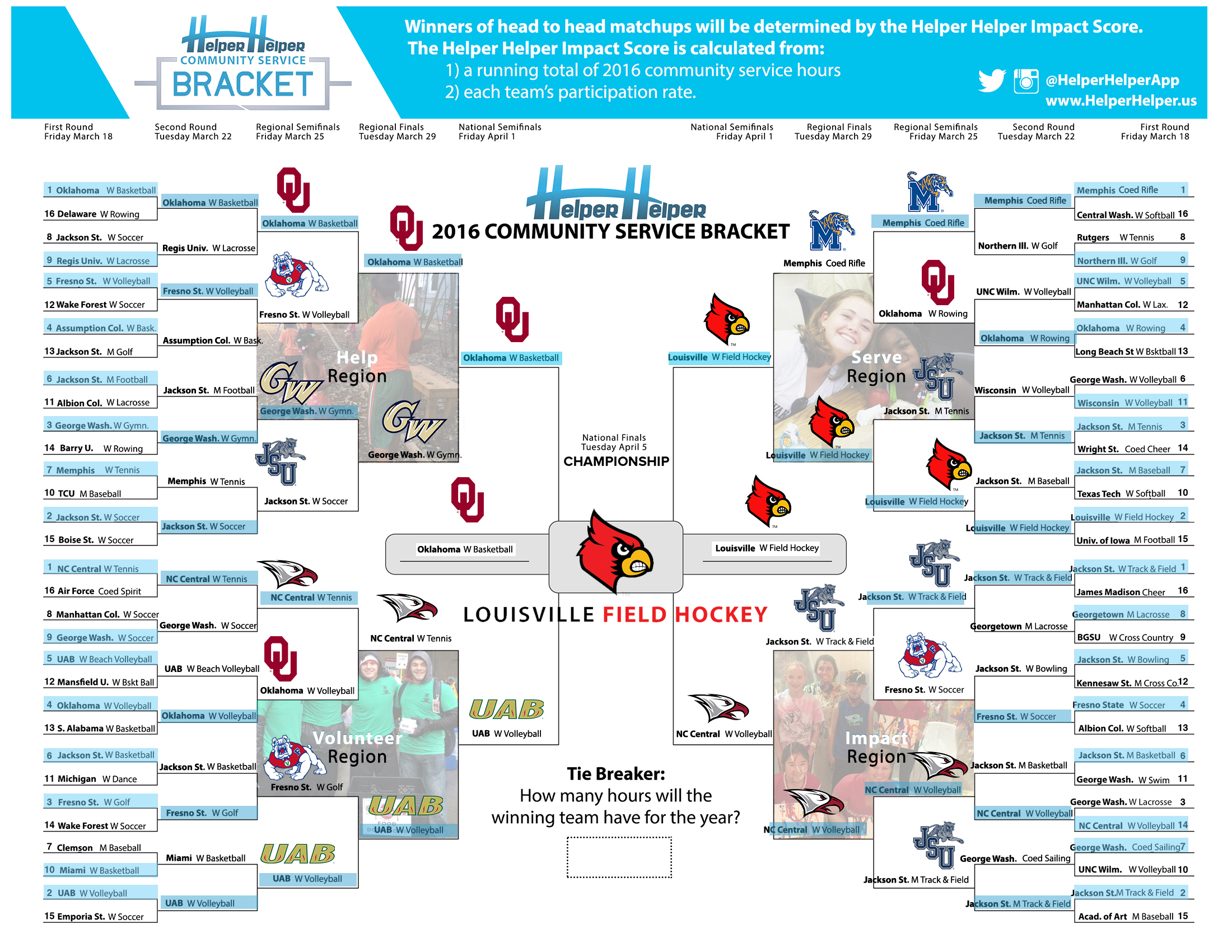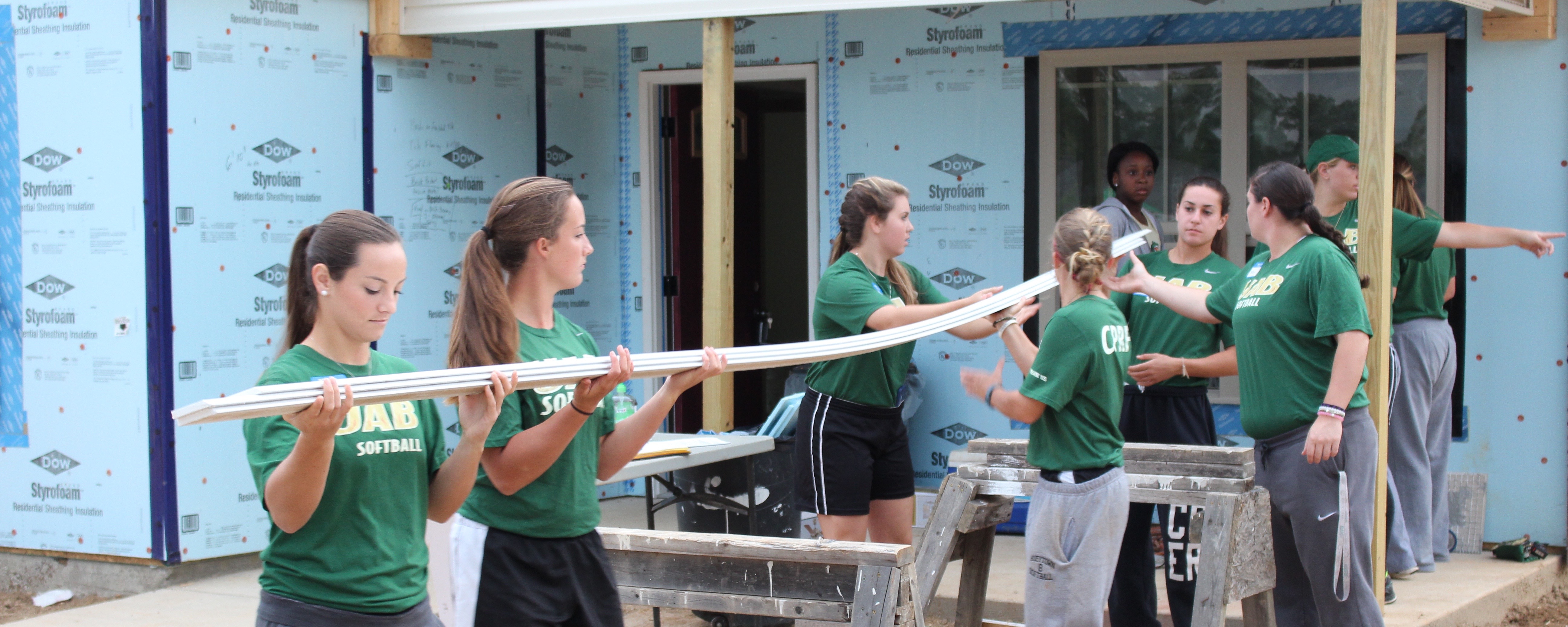Service builds strong leadership skills, so it makes sense that we would want to engage more students to get out and do good work for their community. The struggle comes, though, in making the switch to being excited about work outside of the classroom, managing logistics, and doing authentic, meaningful work.
Since 2015, the Helper Helper team has worked with colleges and high schools to make a drastic and immediate impact in their community through service challenges. As of this writing, we’ve helped over 104,000 students across more than 380 schools give in excess of half a million hours to their communities. Here are some best practices we’ve learned along the way.
1. Set a Goal for Your Students
From academics to athletics. From marathon training to sales. Stating and committing to measurable goals by a set date is one of the best first steps toward accomplishing goals and changing behavior.
Some groups like NHS and entire states like Maryland will set these goals with a minimum required number of service hours. That method works; at Helper Helper, we also like to set milestone goals for students to accomplish as a group.
During the fall of 2015, for example, all of the 100+ schools participating in the Helper Helper challenge set a goal of having each group get 80% of its students to perform a combined 500 hours of community service hours with a clear deadline three months from the start date.
The results came in to 71,526 hours of service and $1.6 million economic impact (or just over 715 hours of impact per school).
Measurable goal x defined amount of time = major impact.
2. Curate Opportunities Students Care About
There’s no question about it: people are more likely to volunteer to do work they’re excited about. And they’re more likely to be excited by work they feel some connection to.
Because of this, we encourage schools to work with community organizers and students to curate service opportunities.
We advocate for students to be involved in this process because students have higher increases in character traits like self-confidence and critical thinking skills when they have ownership over the planning of their service.
At the same time, teachers and other staff are a wealth of knowledge of existing relationships with the community. For this reason, adults in the building must also take the responsibility to submit service opportunities.
The important piece here is to avoid copying and pasting an outdated or unreviewed list. Excess overwhelms people when making decisions. Also, if there are too many options, then it will become difficult for students to find the service that resonates with them.
Share quality opportunities with students and enroll them in the process of identifying and developing their service commitment.
3. Encourage Friendly Competition
Let’s get a misconception out of the way: friendly competition IS NOT AT ODDS with community service.
Friendly competition gets people excited, brings them together, and pushes them to do more.
This is why Helper Helper hosts our community service challenges: to get more students involved and push themselves to do more work for the community.
Some of our highest contributing groups of students in previous challenges have benefited greatly from friendly competition. In fact, some colleges even participated in a bracket-style tournament to push each other to increase their impact:

Teams cooperating and being challenged by other teams pushes all to do more.
4. Connect Service To Students’ Learning & Reflect
Those of us familiar with service learning know that community service can have direct ties to the objectives in the classroom. As teachers facilitate critical thinking, a solid technique is to have students apply their learning in a new environment.
Applying knowledge from the classroom to the service in the community through reflection and dialogue skyrockets learning.
Building a house or other structure? That’s a great opportunity to talk about geometry. Planting a community garden? Let’s talk about the ecosystem or the history of irrigation or the social impacts of sustainable farming.
Take the learning outside of the classroom.
5. Track Your Progress
To support tips 1 and 3 (set goals and encourage competition), you need to track your students, groups, and schools’ progress during your push for an increased commitment to community service.
Many of us have used paper/pencil sheets to log our hours. And others of us have had to take those papers and change our jobs to full-time data entry to get them into a spreadsheet.
While this might get you by with a small group of 10 or fewer students volunteering once every month or so, the paper and spreadsheet method will not cut it if you want to make a noticeable increase in how your students impact your community.
Helper Helper’s web portal and app make this tracking easy. In addition to other benefits, the software allows students to input their hours from an app on their phone when they go to their community service commitment. Then, school staff view hours and run reports from the web portal (and add more community service opportunities).
Since this is such a powerful part of making a greater impact in the community, Helper Helper provides free access to the web portal and app for any school participating in one of our community service challenges.
Move to the digital world while tracking your students’ progress to their goals.
So What Now?
Any time is a good time to start getting students more involved in community service. At Helper Helper, we’re hosting a free challenge for high schools to get out in the community and do amazing work between March and April. We’d love for you to join us.
To take the next step in getting more of your students engaged in community service, register for a Helper Helper demo. A Helper Helper team member will connect with you to learn more about how our platform helps schools and students make a difference.


3 comments
Join the conversationTwitter Takeover: Texas Tech Athletics | Helper Helper - January 22, 2020
[…] Texas Tech University Women’s Softball Team did a Twitter Takeover of the @HelperHelperApp Twitter Account during the STARR pep rally event at Ervin […]
Twitter Takeover: Cameron University | Helper Helper - January 22, 2020
[…] Cameron University Men’s Basketball Team did a Twitter Takeover of the @HelperHelperApp Twitter Account while visiting a local Elementary School! […]
How Do You Measure Student Athlete Success? As Told in Quotes - January 20, 2020
[…] a commitment to service during an athlete’s 4-years in college help athletes transition out of competitive sports and […]
Comments are closed.